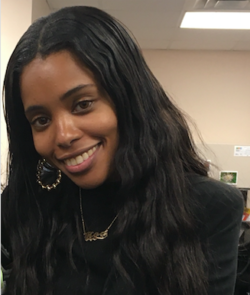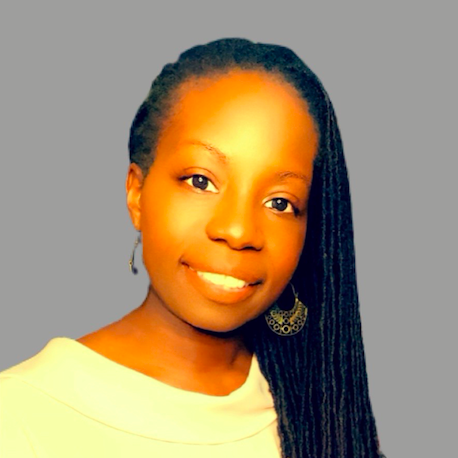
Dr. Shequana Wright-Chung
Guest blog by Melissa Oliver
Think back to when you were a student sitting in a math classroom. Did you believe you could excel at math? If you didn’t, you aren’t alone. Dr. Shequana Wright-Chung, Adjunct Assistant Professor of Early Childhood Mathematics Education at Brooklyn College at the City University of New York, shares that it’s a common belief and one that is often impacted by racial identity and racial bias—our own internalized biases and those of our educators. In this blog, learn more about how Dr. Wright-Chung develops culturally-sensitive math educators who are mindful and aware of racial biases and how they impact students’ mathematical learning. It starts with…a story.
“I always thought I was not great at math,” Dr. Shequana Wright-Chung recalls a teacher candidate sharing last semester. It’s not an uncommon belief. Thinking back to the good ole days of a weekend brunch with six of your closest friends, how many jokes would come up at the table about not being a math person when the bill arrives? The truth is, there is no Math nation with Math citizenry. Math people aren’t born, they’re developed.
So, what impact does it have on students’ ability to excel at mathematics when their teachers are math averse? How do educators’ mindsets about content and student (assumed innate) ability to learn shape academic achievement? How does an educator’s racial identity and what they’ve internalized about their racial group in relation to math dictate the expectations they develop about same-race-students’ math abilities? How does what educators believe about other racial groups’ math aptitude impact the way they teach?
So much of what makes educators great is our ability to reflect. Reflection, however, comes after an action has occurred or a decision made. Dr. Wright-Chung wondered what would happen if she supported teacher candidates with uncovering the mindsets behind their actions to refine the process of reflection that would ultimately improve teacher practice and student achievement. She begins the semester teaching math education through storytelling.
“My class is their last stop before student teaching,” Dr. Wright-Chung shares, “and I want [teacher candidates] to really reflect on their math history and pedagogical stance. How does their past experience, their racial identity, impact the way they approach math? I want them to reflect on their past and current math experiences, and analyze how those experiences influence how they’re going to teach young children. They’re working with students from birth to second grade, the ages where students are developing their mathematical identity.” She paused during our conversation to reflect on her son, a 1-year-old, “African American and Asian boy whose last name is Chung,” making the personal connection to her work. She wants her son’s teachers to see him as a doer of math—not to overlook him or make assumptions because of his South Korean last name or brown skin. She recognizes the very real possibility that her students could, one day, be teaching her son.
Her first assignment, writing a math autobiography, helps her get to know students as well as share her own math history. Beginning with their stories, she believes, lays the foundation for sifting through mindsets, discussing racial equity and how race and gender intersect in the classroom. Developing “racial literacy in students as they learn to teach math,” she highlights, is integral to disrupting the systemic inequities that create racial disparities in education.
Beyond teaching equations and formulas, Dr. Wright-Chung sees teachers as interrupters and uses the math autobiography to “provide [teacher candidates] with opportunities to realize they can make change. We do a lot of asset-based learning, and from there I introduce them to the Cycle of Socialization to help them understand where their math identity was formulated. [Many] were socialized at home that women were not doers of math.” In guiding candidates through the Cycle of Socialization, she realized, “they were stuck on gender, and I started pushing in on race. In my classroom, [my students are roughly] 50 percent Asian, 15 percent African American, maybe 15 percent Latinx and 20 percent white. We focus on gender, but also the differences in race. For example, Asian women were expected to do better in math although non-Asian women weren’t necessarily encouraged to excel in math,” she shared of students’ experiences.
Prioritizing developing students’ racial literacies through writing and sharing math autobiographies helped the class debunk racial stereotypes about math. Dr. Wright-Chung shared that an Asian student expressed, “I feel so dumb because everyone expects me to do well in math so I don’t get the support I need.” On the other hand, an African American student shared, “I love math, but never was supported to excel in math. I was encouraged to write or do something else.” Uncovering mindsets about how our racial identities impact both our math ability and how math is taught helps educators break out of the cycle of socialization in order to have more positive impacts on students. Understanding their own math history and how their math identity developed keeps teacher candidates from “perpetuating the same damaging mindsets” with their own students. Writing their math autobiography widens their aperture and gives them a deeper understanding of what it means to be a math teacher.
Not only did writing a math autobiography help students understand themselves as learners and doers of math, but it also helped broaden their perspectives about others’ experiences. After hearing the math histories of classmates, a white student in Dr. Wright-Chung’s class shared, “I always thought I was not great at math, but I didn’t understand how race also played a factor. People looked at me like I was supposed to get it, and my math knowledge was valued. Other students—students of color—didn’t have their knowledge valued.” The assignment is an important lesson as teacher candidates prepare for student teaching and on valuing what all students bring to the classroom instead of letting racial implicit bias take over.
Another student takeaway was a broadened understanding of what it means to be an equitable educator. “I thought equity was about differentiation,” a student shared, “but I realize that body language and relationships also impact math knowledge.” Writing their math autobiography helped this student reflect on how teachers’ interaction with them impacted their ability to learn. The experience was a powerful reminder that students don’t just learn content from teachers, but that they also develop mindsets and self-esteem based on a teacher’s approach.
In reflecting on teacher candidates’ takeaways, Dr. Wright-Chung expressed that teaching during the Covid pandemic provided additional opportunities for her to model responsiveness and flexibility to students. She thought back to one student who questioned, “When we do math in this way, are we not really addressing the content?” The student’s question prompted Dr. Wright-Chung to make the connections between math and culture even though the student believed that culturally responsive math teaching was a disservice to math education. They had conversations about empathy, an integral component of culturally responsive teaching, and what it takes to be a math teacher that’s impactful to students. The teacher candidate’s thinking began to shift early in the semester but even more so while experiencing Covid-related trauma. Dr. Wright-Chung’s empathy, flexibility and responsiveness to students’ experiences ultimately helped this teacher candidate understand the importance of developing a culturally responsive pedagogy as a math educator. Dr. Wright-Chung credits the assignment with allowing her to deepen and sustain relationships with teacher candidates.
When asked what advice she has for others who want to use this resource with their own teacher candidates and teacher educators, she said it’s important to start with your own story and identity. “You don’t just give a student an assignment without doing it yourself. I share my math history, my pedagogical stance. It’s important to learn about the Cycle of Socialization. Engage with students—be open and honest—so that when they share their narrative, there are connections. We’re all learners in the space, and that gets students to be more open and honest without judgement.”
Another thing that Dr. Wright-Chung thinks it is important for practitioners to know to be able to successfully use this resource in their own practice is, “the importance of racial equity in math teaching. I give an article, ‘Does Race Matter?’ and we discuss how race impacts students’ opportunities to experience mathematics. It would be helpful for practitioners because they have to understand their own bias toward students and reflect on it. Really getting professors to see where their biases are as well is important in exploring the process. As professors we have to be accountable to ourselves about racial equity and consider how we’re sharing it across the university.” She also highly recommends Dr. Barbara Love’s work around developing a liberatory consciousness.
To conclude, Dr. Wright-Chung wants to emphasize that students’ critical reflections do not end with the autobiography assignment. Throughout the semester, Dr. Wright-Chung facilitates time for teachers to reflect on teaching and learning practices in efforts of building their own capacity with identifying and questioning beliefs, assumptions and practices that may lead to racial and race-intersectionality inequities as they engage in classroom observations and child case studies, as well as design and facilitate math lessons.
| Resource Center
You can find Dr. Shequana Wright-Chung’s reflexive assignment here. The goals for this reflexive assignment are for teacher candidates to:
You can also learn more about the Cycle of Socialization and On Educating Culturally Sustaining Teachers, which Dr. Wright-Chung references. To learn more about critical teacher educator practices, read the Teacher Educator Practice Framework which identifies promoting principles of diversity, inclusion, equity and social justice as a critical practice. This practice encourages teacher educators to actively address patterns of inequity by modeling principles of diversity and inclusion and promoting equity and social justice in the daily work of teacher education, as well as using this lens to inform all other practices. |
This post is part of a blog series authored by leaders from seven networks of teacher preparation programs—Branch Alliance for Educator Diversity, Center for Transforming Alternative Preparation Pathways (CTAPP), Innovation Center for Educator Preparation (IC4EP), National Center for Teacher Residencies (NCTR), New York City Department of Education, TeachingWorks, and University-School Partnerships for the Renewal of Educator Preparation (US PREP)—who are working together to transform the way teachers are prepared. In this series, these leaders talk about who they are and why they want to tell stories about teacher transformation. Read the previous blogs here, and don’t forget to share the series with your colleagues. Feel free to send comments to info@education-first.com and sign up for our email list. We’ll be using #teacherprepmatters to spread the word, and invite you to do the same!

